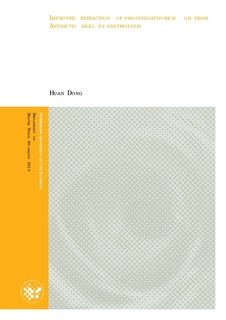| dc.description.abstract | The aims of this research project were to identify a functional protease and optimize
hydrolysis conditions for this enzyme to facilitate efficient alcohol extraction of
phospholipid (PL)-rich oil from Antarctic krill, Euphausia superba. The following
hydrolysis conditions tested were: frozen krill and water ratio (KWR), hydrolysis
temperature (HTe), pH, enzyme dosage (ED), and hydrolysis time (HTi). These
conditions were studied by single factor and orthogonal experiments. Finally, the
efficiency of various solvents used for extracting the krill oil was compared.
Alcalase was identified as the most suitable enzyme for enzymolysis of Antarctic krill
among 5 commonly used enzymes based on the degree of hydrolysis (DH).
The optimal conditions for enzymolysis Antarctic krill with alcalase were: KWR =
2:1, HTe = 55~60ºC, pH = 8.0, ED = 3000 U/g and HTi = 4 h (end pH = 6.5~6.7).
Range analysis in orthogonal experiments gave the following ranking of influencing
factors: KWR (R = 6.2) > ED (R = 2.3) > pH (R = 0.3) > HTi (R = 0.2). Under the
optimal conditions, the DH was 31.1 %. Meanwhile, peptides with an average length
of 3.2 and a molecular mass of 352 were obtained.
Extraction was performed from “PEF”, defined as freeze dried lipid phase after 75~80℃
for 5 min after hydrolysis, and 600xG centrifugation for 5min. Compared with 5
commonly used solvents, 99.5% ethanol gave the most complete extraction of PL rich
krill oil (KO).
Under the conditions of extraction temperature (ETe) = 45 ºC, PEF and 99.5%
ethanol ratio (PER) = 1:10 and extraction time (ETi) = 3h, highest KO extractability
(m (KO) / m (PEF)) was 74%; PL concentration (m (PL) / m (KO)) was 32.1%; total
KO extractability (m (KO) / m (total lipid in PEF)) was 99.4%; total PL extractability
(m (PL) / m (total PL in PEF)) was 102.8%.
Under the conditions of ETe = 25ºC, PER = 1:6, ETi = 1h, highest PL concentration
was 33.9%; KO extractability was 61%; total PL extractability was 89.5%; total KO
extractability was 82.0%.
Under the conditions of ETe = 45ºC, PER = 1:8, ETi = 2h, highest astaxanthin (AX)
concentration in the extract was 172.2 ppm; KO extractability was 72%; total AX
extractability was 103.9%; total KO extractability was 91.1%.
High acid value (AV) and low PL concentration due to hydrolysis during frozen
storage for 6 months, and lipase and phospholipase (PLase) during the time from
catch until the material was frozen, thawed and incubated. Under the conditions of
ETe = 25ºC, PER = 1:6, ETi = 3h, the minimum acid value was 28.6 mg KOH/g. In conclusion, this application of alcalase for hydrolysis of Antarctic krill resulted in a
high degree of hydrolysis. As a result, lipid and water phase were separated to two
layers, in which the upper layer enriched more fat and less protein. Extraction with
99.5% ethanol from this PEF resulted in total krill oil and phospholipid
extractabilities at nearly 100%. | nb_NO |
